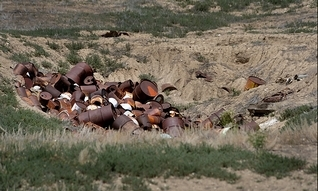05
Oct
Review Confirms Atrazine Harms Fish and Amphibians
(Beyond Pesticides, October 5, 2009) An analysis of more than 100 scientific studies conducted on atrazine, published in the online edition of Environmental Health Perspectives, demonstrates the toxicity of atrazine to aquatic animals. Biologists at the University of Southern Florida (USF) have found evidence that atrazine harms fish and frogs. Atrazine is disruptive to the development and behavior of aquatic animals, and negatively effects their immune, hormone, and reproductive systems, according to the studies done by USF assistant professor Jason R. Rohr and postdoctoral fellow Krista A. McCoy. Atrazine is commonly used on lawns, golf courses, and sugarcane fields in Florida, and has recently been the topic of much controversy.
While atrazine typically does not kill amphibians and freshwater fish, the USF report says it did:
Ӣ Reduce the size of amphibians at or near metamorphosis in 19 of 19 studies.
Ӣ Make amphibians and fish more active in 12 of 14 studies but reduced behaviors used to evade predators in six of seven studies.
Ӣ Alter at least one aspect of male frogs’ reproductive development in eight of 10 studies.
Ӣ Reduce the functioning of animals’ immune systems and often put them at risk of infection.
Atrazine, a common herbicide used in agriculture and on lawns, is already linked to sexual abnormalities in fish. The condition of intersex fish, male fish producing eggs, was most commonly found in smallmouth and largemouth bass. One third of male smallmouth bass and one fifth of the male largemouth bass were intersex. This phenomenon has been linked to atrazine and other chemicals.
Atrazine has been linked to sexual abnormalities in frogs as well as fish. A 2002 study found that when dosed with >.1 part per billion (ppb) of atrazine in water, male Leopard Frogs developed dramatic female sexual characteristics, including retarded gonadal development (gonadal dysgenesis) and testicular oogenesis (hermaphroditism). Joseph Kiesecker of Pennsylvania State University found that exposure to atrazine and other pesticides severely weaken the immune system, making frogs much more susceptible to parasitic infection and deformities.
Richard Levey, a biologist with the Vermont Agency of Natural Resources, said two common farm chemicals, atrazine and metolachlor, had been found in trace amounts in water from wetlands where deformed frogs had been found. He told the AP that the concentrations were far below those thought to have any effect on aquatic life.
Research by Tyrone Hayes, Ph.D., a professor of Integrative Biology at the University of California, Berkeley, has found pesticides, including atrazine, to cause serious deformities at levels well below EPA drinking water standards. Dr. Hayes has shown that exposure to doses of atrazine as small as 0.1 parts per billion – a level permitted in drinking water by EPA – turns tadpoles into hermaphrodites – creatures with both male and female sexual characteristics. Dr. Hayes’ team found that up to 20 percent of frogs exposed during their early development produced multiple sex organs or had both male and female organs. Many also had small, feminized larynxes.
Recent reports find EPA’s regulations of atrazine in water to be insufficient. The analysis by the Natural Resources Defense Council (NRDC), Poisoning the Well, discovered that in the 139 municipal water systems from which EPA collected data on a biweekly basis in 2003 and 2004, atrazine is found 90% of the time. 54 of these water systems have at least one spike above 3 parts per billion (the supposed acceptable level for human consumption).
Furthermore, studies from 2007, done by researchers at the Centers for Disease Control (CDC), have determined that previous studies that assessed population-based exposure to atrazine were significantly and systematically underestimated. With the growing proof of the negative effects of atrazine, levels of exposure need to be properly monitored and accounted for. Ideally, public health advocates have argued that exposure to atrazine should be eliminated entirely through its cancellation.
This comprehensive review demonstrates the urgent need for EPA to cancel atrazine uses. Atrazine was banned in Europe in 2004, and with good reason. Atrazine is an endocrine disruptor, and can lead to neuropathy and cancer. Atrazine stays in the environment for long periods of time; it can stay in soil for longer than one year under dry or cold conditions. There is no need to continue with the use of atrazine, especially with so many alternatives for pest management. For examples, see our Lawns and Landscapes page and our Organic Food page.
For further information on this issue, please see our Threatened Waters page.
Source: USF News














